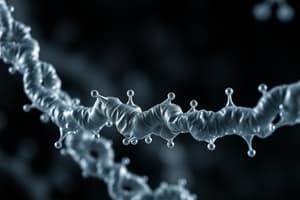Podcast
Questions and Answers
¿Cuál es la función principal de la proteína miosina?
¿Cuál es la función principal de la proteína miosina?
- Regular la temperatura corporal
- Proporcionar estructura a las células
- Ayudar en la digestión de los alimentos
- Contraer y mover los músculos (correct)
¿Qué condición puede llevar a la desnaturalización de las proteínas?
¿Qué condición puede llevar a la desnaturalización de las proteínas?
- Exposición a la luz ultravioleta
- Disminución de la presión osmótica
- Aumento de la concentración de proteínas
- Cambios en la temperatura, pH y exposición química (correct)
¿Cuál es el principal tipo de molécula de carbohidrato utilizada en el metabolismo energético?
¿Cuál es el principal tipo de molécula de carbohidrato utilizada en el metabolismo energético?
- Sacarosa
- Glicógeno
- Glucosa (correct)
- Celulosa
¿Cuál es la función principal de los lípidos en forma de triglicéridos?
¿Cuál es la función principal de los lípidos en forma de triglicéridos?
¿Cuál es la principal función de los ácidos nucleicos, como el ADN y el ARN?
¿Cuál es la principal función de los ácidos nucleicos, como el ADN y el ARN?
Study Notes
Biomolecules: An Educational Perspective
Every living being on our planet is constructed from biomolecules. These organic substances provide the basic building blocks for every cell and tissue in our bodies and even microorganisms. Biomolecules are incredibly diverse molecules that perform various functions essential for life. They include proteins, carbohydrates, lipids, and nucleic acids, each playing unique roles in cellular processes. This article will delve into these biomolecules, providing a fact-rich overview of their properties, structures, and functions.
Proteins
Proteins are complex macromolecules made up of one or more long chains of amino acid units connected by peptide bonds. They have a wide range of functions, including acting as enzymes, hormones, antibodies, and structural components of cells. The structure of proteins can be classified into four levels: primary (the linear sequence of amino acids), secondary (folding patterns, like alpha helices and beta sheets), tertiary (three-dimensional conformations with specific folds), and quaternary (multiple protein subunits associated together).
Structure and Function
The amino acid composition of a protein determines its overall shape and function. Proteins play crucial roles in our body, from building and repairing muscles to regulating critical cellular functions. For example, hemoglobin, a globular protein found in red blood cells, carries oxygen throughout the body. On the other hand, myosin, another type of protein, is responsible for muscle contraction and movement.
Regulation and Denaturation
The shape and function of proteins are highly dependent on factors like temperature, pH, and chemical exposure. Any alteration in these conditions can lead to protein denaturation, causing a loss of its original form and functional capabilities. A well-known example is cooking an egg; when exposed to heat, the albumin protein inside the liquid egg white undergoes denaturation, changing from a clear substance to an opaque white one.
Carbohydrates
Carbohydrates are organic compounds composed primarily of carbon, hydrogen, and oxygen atoms. Also known as saccharides, they serve as the most abundant dietary source of energy for living organisms. Classified according to the number of sugar monomers, they include monosaccharides (single sugar unit), disaccharides (two units), and polysaccharides (many units).
Structure and Function
Monosaccharides are the simplest carbohydrates and act as building blocks for more complex ones. For example, glucose is a monosaccharide commonly used in energy metabolism. Disaccharides are formed by linking two monosaccharides together, while polysaccharides consist of long chains of monosaccharides. Examples of polysaccharides are cellulose, which forms the cell walls of plants, and glycogen, a storage form of glucose in animals.
Lipids
Lipids are nonpolar organic compounds that serve various functions within cells. They can be classified into several categories, including fatty acids, glycerol esters (triglycerides), phospholipids, and steroids.
Structure and Function
Triglycerides, composed of fatty acid chains attached to a glycerol backbone, serve as a major energy reserve in living organisms. Phospholipids, which contain two fatty acids linked to a phosphate group on glycerol, are essential components of cell membranes. Steroids, like cholesterol, play roles in hormone regulation and cellular signaling.
Nucleic Acids
Nucleic acids, specifically deoxyribonucleic acid (DNA) and ribonucleic acid (RNA), carry the genetic information of cells. Consisting of nucleotide subunits, these molecules direct cellular activities such as DNA replication and protein synthesis.
Structure and Function
Each nucleotide consists of a pentose sugar, a nitrogenous base, and a phosphate group. The nitrogen bases in DNA are adenine, guanine, cytosine, and thymine, while RNA uses uracil instead of thymine. The double-stranded structure of DNA forms a twisted ladder called a double helix, with hydrogen bonds between complementary base pairs preserving the genetic code.
In conclusion, biomolecules - proteins, carbohydrates, lipids, and nucleic acids - are crucial for life's functioning at all levels. Their structures and functions are intricately interconnected, ensuring that every cell and organism operates optimally. Understanding these molecular entities allows us to appreciate the complexity and beauty of biological systems.
Studying That Suits You
Use AI to generate personalized quizzes and flashcards to suit your learning preferences.
Description
Explore the world of biomolecules - proteins, carbohydrates, lipids, and nucleic acids - and their vital roles in cellular processes and life itself. From the structure of proteins to the genetic information carried by nucleic acids, learn about the diverse functions and significance of these organic compounds.




